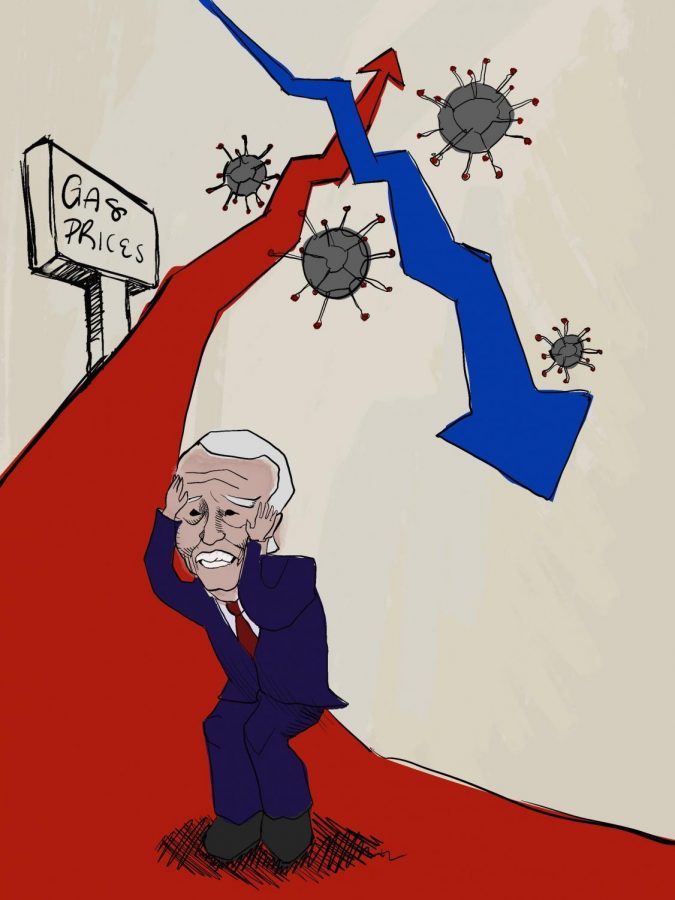Why Democrats Have a Gloomy Midterm Outlook
Graphic Design: Carmen Miskel
It is safe to say that with record inflation, concerns over the price of gas, a humiliation in the Middle East, and another crisis of confidence, the first year of Joe Biden’s presidency has had a rocky start.
Biden’s approval rating currently sits at a feeble 42.4%, one of the worst on record for any president at this point in his administration. An ABC News & Washington Post poll released on November 10th showed Republicans ahead by ten points on the generic ballot, and a survey by The Economist revealed that 60% of respondents believe that the country is moving in the wrong direction. These numbers are shocking when a year ago Joe Biden received the most votes of any presidential candidate in history; he committed the ultimate political victory of unseating an incumbent US President. And yet, he is on track to be a lame-duck president in only his first year.
If it wasn’t apparent, American politics are always more complicated than they seem. It’s important to remember that three states – Georgia, Arizona, and Wisconsin – all decided Biden’s presidency by an average of 14,106 votes. Suburban Independents and moderate Republicans were the keys to a successful Biden coalition. And yet, Biden’s approval rating with these demographics has appeared to falter.
In the recent Virginia gubernatorial race, Republican businessman Glenn Youngkin caused a national upset when he emerged as a total dark horse to defeat former Democratic Governor Terry McAuliffe. Youngkin won the Virginia suburbs that had previously deserted Trump by campaigning on local issues such as fear about critical race theory in schools, vaccine mandates in place due to COVID-19, and taxation.
With McAuliffe having Biden and Vice-President Kamala Harris campaign on his behalf, he nationalized the race causing the result to turn into a referendum on the current administration. In fact, Biden repeatedly denounced Youngkin as a Trump acolyte, which proved to not be enough to sway voters. And in New Jersey, a state that voted for Biden by an overwhelming margin, Republican Jack Ciattarelli nearly unseated incumbent Phil Murphy.
A midterm switch isn’t uncommon; since the end of WWII, the average President has experienced a loss of roughly twenty-six seats in the House of Representatives on average. Yet, at the moment, a net loss of that amount would be a victory in itself for the Democrats. Many of the swing congressional districts are in suburban battlegrounds where the president’s conduct has proven unpopular. During an interview with NPR, a Trump-to-Biden voter vented his frustrations by saying, “[w]hat happened in Afghanistan, to me, was the worst thing that’s happened since Saigon.” He wasn’t alone in his thoughts.
Biden’s approval rating took its first dive during the botched withdrawal from Afghanistan and seemed to slip only downwards from there. Despite his pledge to be more effective at combating the pandemic than his predecessor, more people have died in the year 2021 than in 2020 – despite the availability of the vaccine. While Operation Warp Speed and the vaccine rollout under the Biden Administration have been a tremendous success, many of the vaccinated have lost patience with the number of restrictions and mandates still in place.
The Biden Administration’s plans to address climate change also included a drastic reduction in the number of fossil fuels consumed by the United States beginning with the closure of the Keystone Pipeline. Currently, there are roughly four hundred active oil rigs in the United States, which was less than half the amount under the former president – where
America achieved energy independence. With the Secretary of Energy Jennifer Granholm admitting she is unaware of how much oil is consumed in the United States a day, many Americans have felt that the government is neglecting the issues that are impacting their day-to-day lives.
And the most feared and dreaded enemy of all: inflation. It has made a return, with the highest increase in 31 years according to the U.S Department of Labor. Americans are paying more not only for gas but for energy, used cars, fuel oil, and groceries. With a slow economic recovery and a decline in the workforce participation rate, many Americans are struggling to make ends meet.
Supply chain issues have also plagued the American economy with the government increasing demand through spending rather than strengthening supply with de-regulation and tax incentives. To make matters worse, the pandemic has caused a release of emergency funds by the Federal Reserve causing one in every four dollars in circulation today to have been printed in the last year. With the fate of the Biden Administration’s ambitious $3.5 trillion dollar bill sitting in the Senate, many Americans fear an even bigger inflation spike could be around the corner.
As if matters for the President couldn’t reach more alarming levels, he has also drawn the exasperation of the more youthful progressive wing of his party, which believes he is the lesser of two establishment evils. During the primaries, young voters flocked to Senator Bernie Sanders (I-VT), whose grassroots, populist, socialist campaign nearly captured the Democratic nomination twice, and rejected Biden, who clocked young support in the single digits. While we have seen much anger from Democratic activists and voters on social media platforms directed at the President, it is not a true reflection of the coalition that placed Biden in the oval office.
CNN’s exit polling from the 2020 election showed 68% of Biden voters were voting against Donald Trump, and trusted Biden to handle the pandemic, racial injustice, and to protect the affordable care act. Biden was not, however, given the mandate to govern progressively – the number of split ballots that enabled Republicans to gain seats in the house proved that he did not have the same coattails as other historical Democrats, like Franklin D. Roosevelt, who enlarged and reformed the Federal Government. Biden’s struggle to pass his Build Back Better act is proof that instead of trying to mandate a progressive reform, he should take a deep breath, negotiate, and make concessions to the more moderate senators.
With Americans paying more at the pump, feeling the effects of inflation at the grocery store, and taking in the results of the first year of the Biden Administration, it is clear that the country is potentially set up for a red wave. With a five-seat majority in the house and an evenly divided Senate (with Vice-President Harris being the potential deciding vote), unless Joe Biden can successfully conjure the unity he’s been so adamant in pleading for, it seems he could be the first president since Eisenhower to lose control of both chambers in one election, dooming his presidency.

Carmen, a senior this year, is excited to continue helping out with the banner. Outside of school, she enjoys art, sleeping, and going on walks. She claims...


